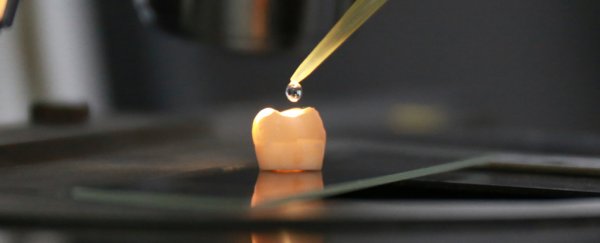It's the hardest substance in the human body, and it's irreplaceable. Around the world, billions are affected by tooth decay stemming from the loss of tooth enamel, but new research offers fresh hope to end this global problem.
Scientists in China have developed a liquid solution that can effectively grow back the external surface of damaged tooth enamel, using a material that mimics the natural mineralisation process of our teeth's protective outer layer.
Tooth enamel is formed in a biomineralisation process whereby cells called ameloblasts secrete proteins that eventually harden into that tough external coating of our teeth.
The problem is that ameloblasts are only present during tooth development, meaning our mature teeth have virtually no natural ability to self-repair after they've formed.
Scientists have tried a range of approaches to artificially coax enamel re-mineralisation, but according to researchers from Zhejiang University, previous attempts have mostly failed, because the complex, crystalline structure of enamel has never been successfully replicated in the lab.
At least, not before now, the team suggests in a new paper.
"We herein reveal that a rationally designed material composed of calcium phosphate ion clusters can be used to produce a precursor layer to induce the epitaxial crystal growth of enamel apatite, which mimics the biomineralisation crystalline-amorphous frontier of hard tissue development in nature," the researchers, co-led by biomimetics and materials scientist Zhaoming Liu, write in their study.
The achievement, which the team is billing as a world-first, required a new kind of calcium phosphate ion clusters (CPICs), measuring just 1.5 nanometres in diameter (about one billionth of a metre).
These tiny particles were then stabilised in an ethanol solution with a chemical called triethylamine, which prevents them from clumping together.
When their gel-like material was applied to human teeth donated by patients, the ultra-small clusters successfully fused to the fish-scale-like structure of native enamel, replicating the coating of the tooth with an indistinguishable and equally hard repair layer that developed to a thickness of up to 2.8 micrometres within 48 hours.
 (Zhejiang University)
(Zhejiang University)
Above: Human tooth enamel after repairing for 6 hours, 12 hours, and 48 hours. Native enamel in blue, repaired enamel in green.
While that's hundreds of times thinner than a full layer of natural tooth enamel, the team thinks that repeated coatings with their CPIC solution could effectively thicken the artificial enamel, and that further refinements to the material could augment its thickness.
"Our newly regenerated enamel has the same structure and similar mechanical properties as native enamel," Liu told Sky News.
"We hope to realise tooth enamel regrowth without using fillings which contain totally different materials and we hope, if all goes smoothly, to start trials in people within one to two years."
To meet that timeframe, the team will need to demonstrate that their material is safe – especially since there are concerns about the toxicity of triethylamine, which is used as the stabilising compound.
The researchers say the chemical evaporates in ethanol during the process, so should not pose a risk, and are currently testing the substance in mice, in the lead-up to hoped-for clinical trials.
In the meantime, experts say it could be several years before this material finds its way into clinical use at your local dentist – provided future tests indicate it's both safe and effective.
Until such time, conventional advice on dental health remains as sound as ever.
"Prevention is the best approach," biomedical researcher Chen Haifeng from Peking University, who wasn't part of the study, told the South China Morning Post.
"We should never wait until the damage is done. Our teeth are a miracle of nature. Artificial replacement will never do the job as well."
The findings are reported in Science Advances.
